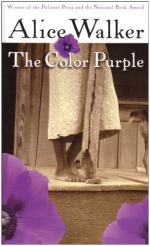|
This section contains 2,681 words (approx. 9 pages at 300 words per page) |

|
SOURCE: Warhol, Robyn R. “How Narration Produces Gender: Femininity as Affect and Effect in Alice Walker's The Color Purple.” Narrative 9, no. 2 (May 2001): 182-87.
In the following essay, Warhol explores the sentimentality of the themes and narrative in The Color Purple, and analyzes the reasons for a feminine gender designation to sentimental and emotional stories.
Having a good cry is a feminine thing to do. In British and American mainstream culture of the nineteenth and twentieth centuries, weeping openly and emotionally—whether for grief, anger, frustration, sympathy, relief, joy, triumph, or gratitude—is an activity associated with girls and women, considered appropriate to their female frames and feminine feelings. Men cry, too, of course: if they are gay men, their tears are understood as part of the penchant they are supposed to share with feminine women for “making a spectacle” of their feelings;1 if they are straight, they must...
|
This section contains 2,681 words (approx. 9 pages at 300 words per page) |

|


